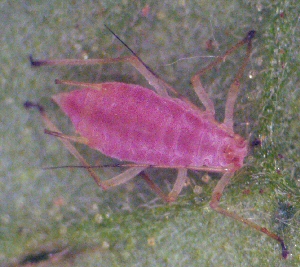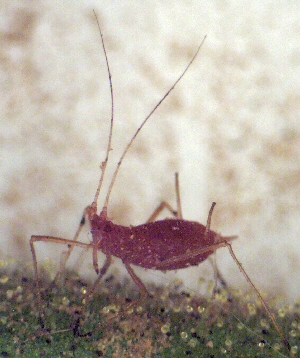Potato Aphid
 Scientific Name
Scientific Name
Macrosiphum euphorbiae
Host
Potato aphids infest a wide range of host plants. Some important cultivated hosts include potato, tomato, eggplant, sunflower, peppers, peas, beans, apple, turnip, corn, sweet potato, asparagus, clover, and roses. Weeds such as ragweed, lambsquarter, jimsonweed, pigweed, shepherdspurse, and wild lettuce are also common food plants.
Symptoms
Potato aphid infestations are sporadic in occurrence and rarely severe enough to kill plants. Damage is caused by both nymphs and adults sucking sap from foliage, especially from the terminal growth. New growth may become stunted and curled. The transmission of tomato and potato diseases, such as mosaics, leaf roll, and spindle tuber, causes more injury to the plants than sucking the sap.
Life Cycle
 In the Northern states, winter is passed in the egg stage, principally on cultivated
and wild rose bushes. These eggs hatch in the spring into wingless females which give
birth to living young. With the coming of cool weather in the fall, winged aphids
fly to the winter hosts and produce females which mate and deposit overwintering eggs.
Farther south, eggs and males are not produced and female aphids feed and reproduce
without mating year-round. Each female gives birth to about 50 nymphs. During warm
weather, each of these nymphs matures in two or three weeks. The life cycle continues
in this manner until overcrowding occurs or food becomes scarce. At these times, nymphs
develop into winged adults and migrate to new host plants. Once settled down, these
aphids begin reproducing and the life cycle continues as before. Numerous generations
are produced each year.
In the Northern states, winter is passed in the egg stage, principally on cultivated
and wild rose bushes. These eggs hatch in the spring into wingless females which give
birth to living young. With the coming of cool weather in the fall, winged aphids
fly to the winter hosts and produce females which mate and deposit overwintering eggs.
Farther south, eggs and males are not produced and female aphids feed and reproduce
without mating year-round. Each female gives birth to about 50 nymphs. During warm
weather, each of these nymphs matures in two or three weeks. The life cycle continues
in this manner until overcrowding occurs or food becomes scarce. At these times, nymphs
develop into winged adults and migrate to new host plants. Once settled down, these
aphids begin reproducing and the life cycle continues as before. Numerous generations
are produced each year.
Description
This soft-bodied, pear-shaped insect varies in color from solid pink to green and pink mottled to light green. It is a rather large aphid, almost 1/8 inch long, and has a pair of long, slender "tailpipe-like" appendages known as cornicles. Immature aphids are smaller than adults but similar in color and shape. All stages have piercing-sucking mouthparts and feed by sucking sap from plant tissues.
Control
Please contact your local county extension office for current information.
